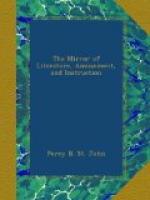Such are the principal parts of the cathedral which have suffered. The books, cushions, and other movable effects, from the northern side of the choir, were fortunately rescued, together with the brazen eagle, from which the prayers were read. The wills, and other valuable documents, were also preserved.
The choir, the destruction of which we have just related, was built by John de Thoresby, a prelate, raised to the archiepiscopal chair in 1532. On this building he expended the then enormous sum of one thousand eight hundred and ten pounds out of his own private purse. The first stone was laid on the 29th of July, 1361; but the founder died before its completion, as is evident from the arms of several of his successors in various parts of the building, particularly those of Scrope and Bowet, the latter of whom was not created archbishop until the year 1405. It was constructed in a more florid style of architecture than the rest of the fabric. The roof, higher by some feet than that of the nave, was more richly ornamented, an elegant kind of festoon work descending from the capitals of the pillars, which separated the middle from the side aisles; from these columns sprung the vaulted roof, the ribs of which crossed each other in angular compartments. The magnificent window, the admiration of all beholders, occupies nearly the whole space of the eastern end of the choir; it is divided by two large mullions into three principal divisions, which are again subdivided into three lights; the upper part from the springing of the arches are also separated into various compartments. It contains nearly two hundred subjects, principally scriptural. The painting of this window was executed about the year 1405, at the expense of the dean and chapter, by John Thornton, a glazier, of Coventry, who, by his contract, was engaged to finish it within three years, and to receive four shillings per week for his work; he was also to have one hundred shillings besides; and also ten pounds more if he did his work well.[3] On the exterior of the choir, immediately over the window, is the effigy of John de Thoresby, mitred and robed, and sitting in his archiepiscopal chair, his right hand pointing to the window, and in his left holding the model of a church. At the base of the window are the heads of Christ and the Apostles, with that of some sovereign, supposed to be Edward III.
We will now bring this article to a close, by quoting the words of AEneas Sylvius, afterwards Pope Pius II., in praise of York Cathedral. He says, “It is famous all over the world for its magnificence and workmanship, but especially for a fine lightsome chapel, with shining walls, and small, thin-waisted pillars, quite round."[4]




